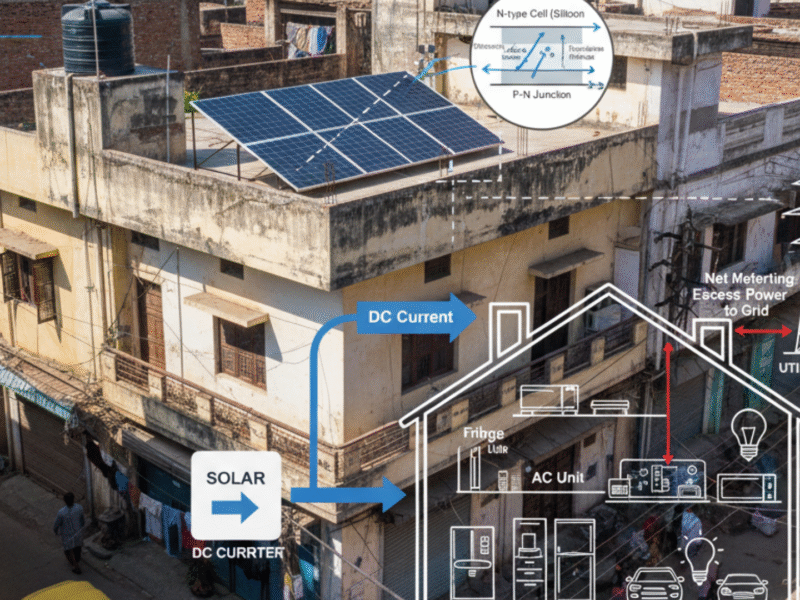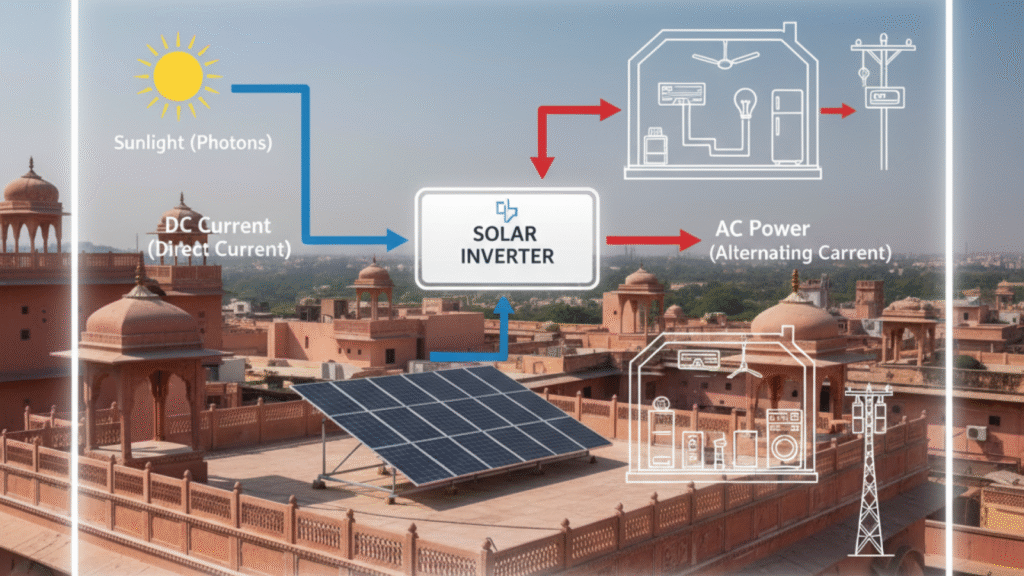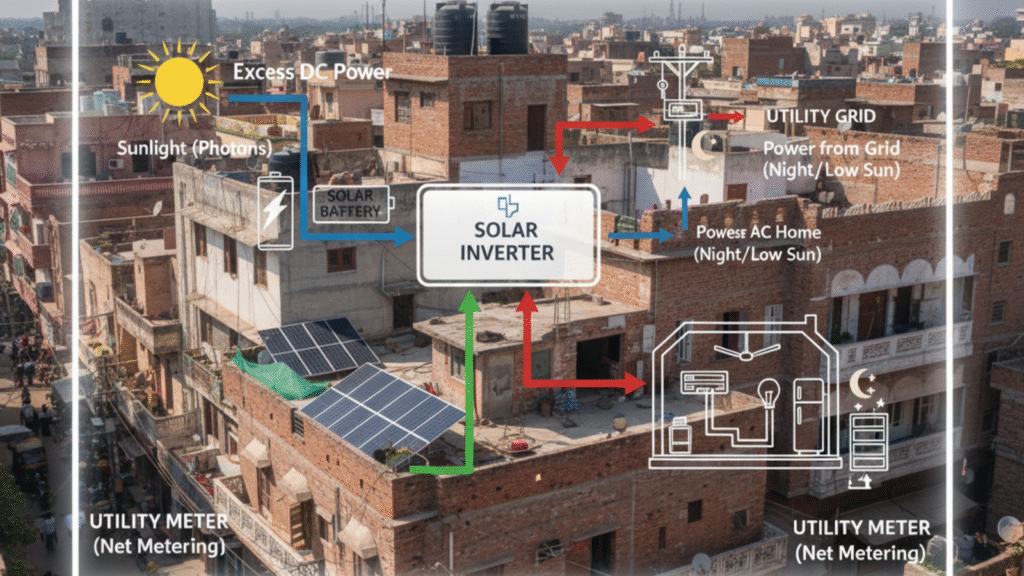
How does solar energy work? This question drives millions of homeowners and businesses toward a cleaner, cheaper, and more sustainable future. While the technology may seem complex, the underlying principle of rooftop solar is remarkably simple and elegant: the photovoltaic (PV) effect.
This comprehensive guide will walk you through the entire process, explaining precisely how solar panels convert light from the sun into usable electricity. We’ll detail the entire journey, from the moment a photon hits your roof to the moment it powers your appliances. By the end, you will easily understand the science and the system components that make solar power generation possible.
The Core Science: Understanding the Photovoltaic Effect

At the heart of the answer to “how does solar energy work” is the science of light conversion. The system depends on solar cells, which are the fundamental building blocks of a solar panel. These cells are typically manufactured from silicon, a semiconductor material specially treated to conduct electricity.
How PV Cells Generate Electricity from Sunlight
The entire process of generating electricity happens in three critical, sequential steps:
Photon Absorption: The Start of Solar Energy Generation
Sunlight is made up of tiny packets of energy called photons. First, when these photons strike the solar panel, the silicon material immediately absorbs their energy. Consequently, the more sunlight the panel receives, the more photons are absorbed, and the more electricity the system can potentially generate.
Freeing Electrons and Creating the Flow
The absorbed energy from the photons is transferred to the negatively charged electrons within the silicon atoms. Specifically, this energy is enough to “excite” those electrons, knocking them loose from their orbits. This sudden release marks the creation of kinetic energy. Then, the silicon cells, which contain an internal electric field (a p-n junction), immediately push these newly freed electrons toward the front layer of the cell. Simultaneously, they push the corresponding positively charged “holes” (where the electron was) to the back layer. This directional movement is what creates a current.
Direct Current (DC) Power Collection
The clear separation of positive and negative charges establishes a voltage, very much like the terminals on a battery. Finally, metal contacts (busbars and finger lines) built into the solar cell collect these flowing electrons, generating Direct Current (DC) electricity. This entire process is the photovoltaic effect—the raw power produced by the panels.
From DC to AC: The Role of the Solar Power System Components

While the PV cells explain how the light is converted, a complete answer to “how does solar energy work” must include the essential components that make the electricity functional in your home. These parts collectively form a successful solar energy system.
Key Components That Make Solar Energy Work
To convert the raw DC power into usable energy and manage the system’s output, several pieces of specialized hardware are required.
| Component | Function | Why It’s Critical |
| Solar Panels (Modules) | Absorbs photons and uses the Photovoltaic Effect to generate DC electricity. | The core energy-producing unit of the system. |
| Inverter | Converts the Direct Current (DC) from the panels into usable Alternating Current (AC). | Essential because homes and the grid use AC power. |
| Racking/Mounting | Provides a secure, weather-resistant structure for the panels on the roof or ground. | Ensures system safety and optimal angle for sun exposure. |
| Utility Meter (Net Meter) | Measures the power drawn from the grid and the excess power sent back to the grid. | Enables the financial benefit of Net Metering. |
| Solar Battery (Optional) | Stores excess DC electricity for use at night or during power outages. | Provides energy independence and reliable backup power. |
How Solar Energy Works: The Critical Role of the Inverter
The DC electricity produced by the solar panels is not directly compatible with most residential or commercial appliances. Therefore, the majority of electrical grids and household devices operate on Alternating Current (AC).
Converting DC to AC: Why Inverters are Essential
The solar inverter is the most vital component after the panels themselves. Its job is to take the variable DC electricity from the solar array and accurately convert it into standard 120-volt or 240-volt AC electricity. Crucially, it must match the frequency (usually 60 Hz) required by the electrical grid.
Central vs. Micro-Inverters: Different Ways to Maximize Efficiency
Modern solar systems typically use one of two main inverter setups:
- Central/String Inverters: A single, large inverter unit connects to the entire array (a “string” of panels). Although these are cost-effective, their performance can suffer if even one panel is shaded.
- Micro-Inverters: Small inverters are installed directly underneath each individual panel. As a result, this allows each panel to operate independently, maximizing the system’s total output even when some panels are partially shaded.
What Happens to Excess Power? Understanding How Solar Energy Works with Net Metering and Storage

A full explanation of “how does solar energy work in a practical sense” must include how your system handles the surplus power generated during peak daylight hours.
Understanding Net Metering and Grid-Tied Systems
The vast majority of residential solar installations are grid-tied, meaning they remain connected to the utility company’s electrical infrastructure. Clearly, this connection is key to maximizing the financial value of your solar production.
The Financial Benefit of Sending Power Back
Net metering is the billing arrangement that allows homeowners to receive credit for the excess electricity their solar system generates and sends back to the grid. In essence, the grid acts as a giant, free battery, holding your credits. When your panels are not producing (like at night), you simply draw standard power from the grid, and those built-up credits offset your bill. Evidently, this mechanism is crucial for making solar economically viable. Without net metering, much of your excess power would be uncredited.
The Role of Solar Battery Storage
For homeowners seeking greater energy independence or reliable backup power during an outage, the inclusion of a solar battery offers the perfect solution.
Storing Power for Nighttime Use
When a battery is integrated into the system, excess DC power is diverted and stored in the battery before it is sent to the inverter or the grid. This capability allows the homeowner to use stored, self-generated power at night, reducing reliance on the utility company to nearly zero and further lowering their electricity costs. Furthermore, for regions with unreliable grid power, battery storage becomes critical to ensure essential appliances keep running during an outage.
Frequently Asked Questions (FAQ) About How Solar Energy Works
Q. How Does Solar Energy Work When It’s Cloudy?
A. How does solar energy work without bright sun? Solar panels do not need direct sunlight; they need light (photons). While output is reduced, panels can still generate 10% to 25% of their normal capacity on heavily overcast days because they still absorb diffused and scattered sunlight.
Q. Do Solar Panels Produce Electricity at Night?
A. No, typical solar panels cannot generate electricity at night because the photovoltaic effect requires light (photons). However, if you have a solar battery, your home will use the energy that was stored during the day, making you energy independent even after sunset.
Q. How Long Do Solar Panels Last?
A. Modern solar panels are extremely durable. The industry standard warranty guarantees at least 80% of the initial power output after 25 years. Most high-quality systems continue to produce usable power for 30 to 40 years, far exceeding the lifespan of the average roof.
Conclusion: Why Understanding How Solar Energy Works is Important
The elegance of the photovoltaic effect, combined with the sophisticated components of the solar inverter and the financial benefit of net metering, makes solar power one of the most reliable and future-proof energy solutions available today. Ultimately, as this technology advances, solar energy systems will become even more efficient and affordable, solidifying their role as a central pillar of renewable energy globally. Understanding these basic principles is the powerful first step toward embracing a greener, more self-sufficient future.

